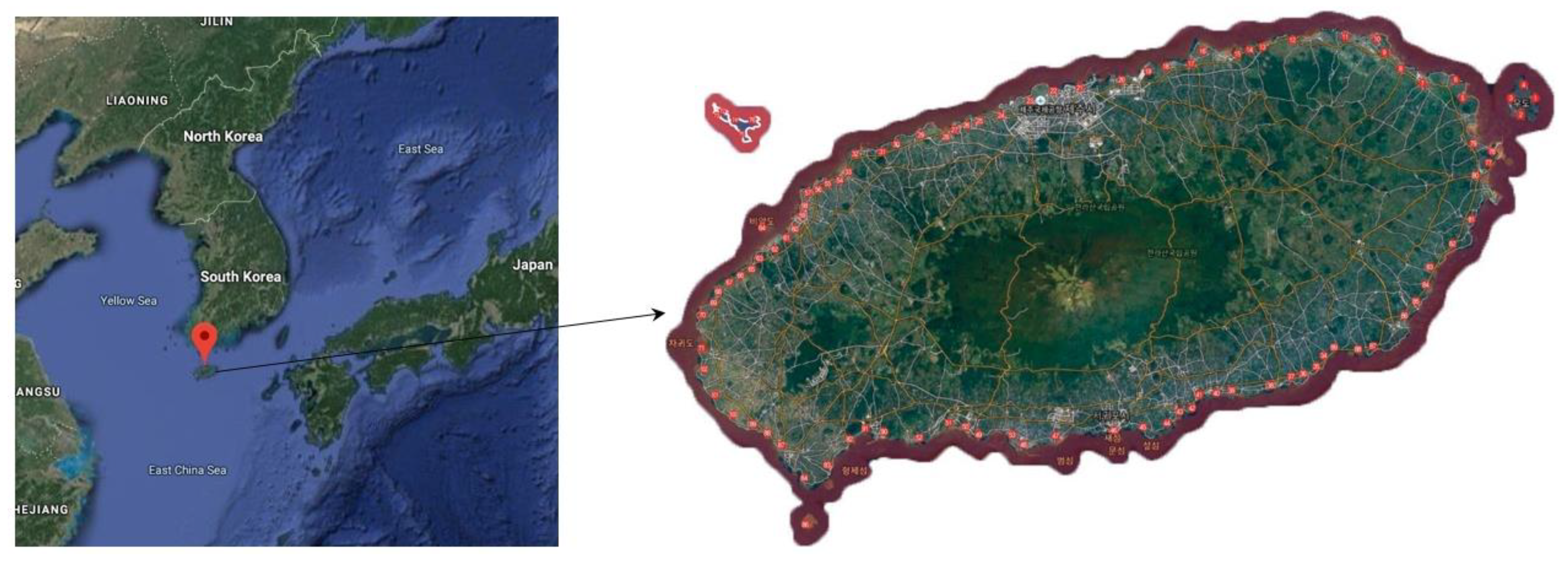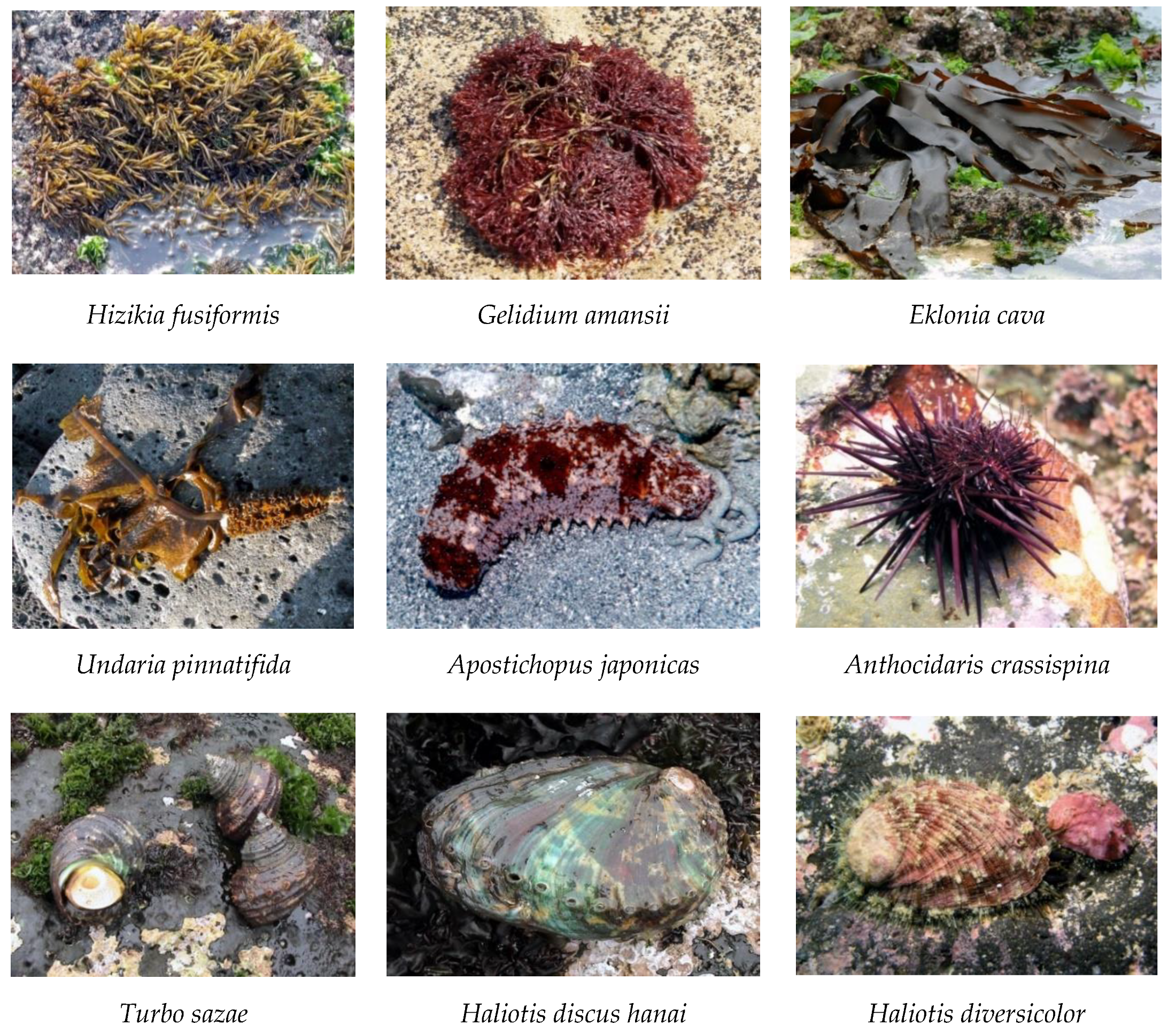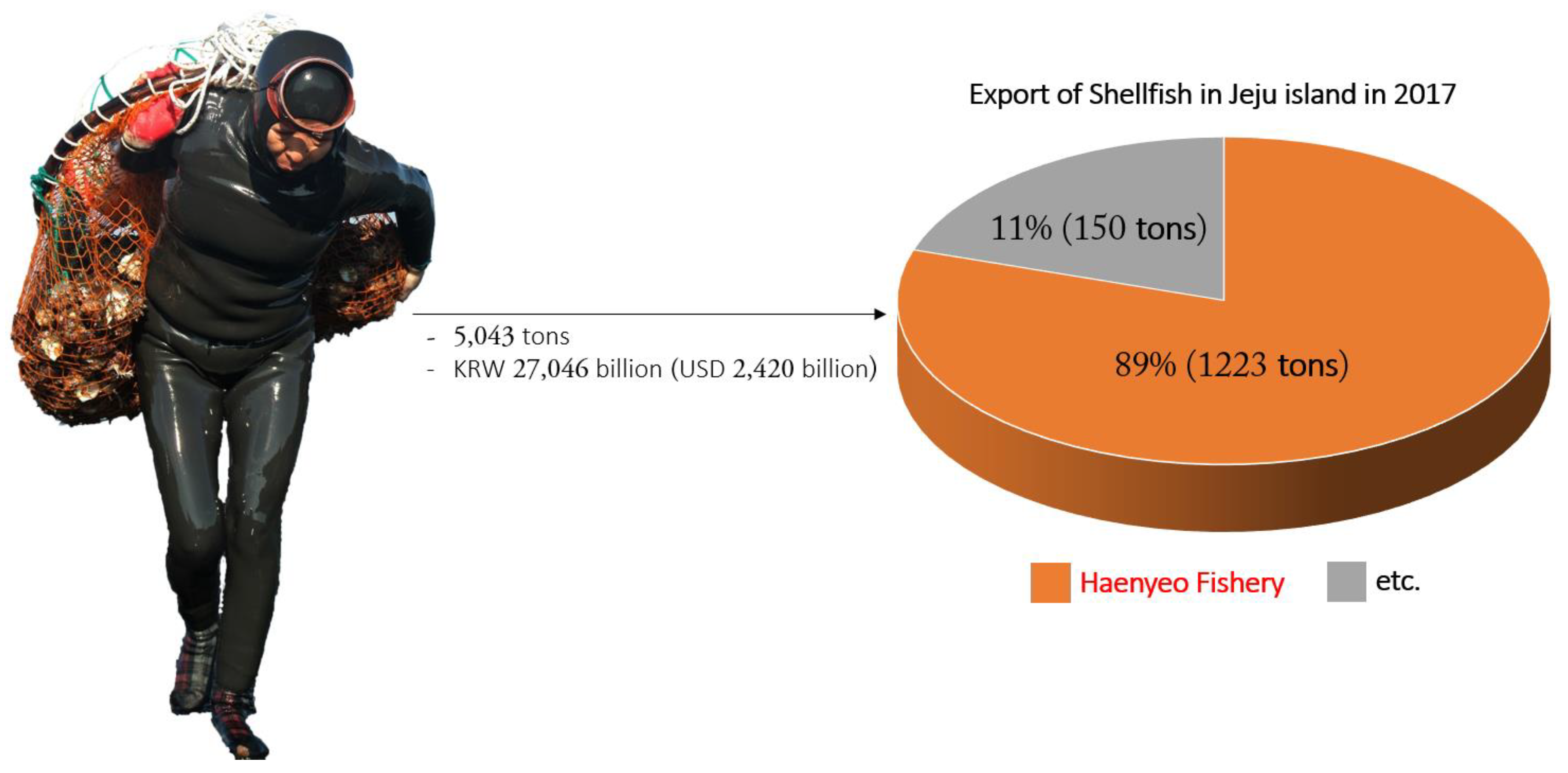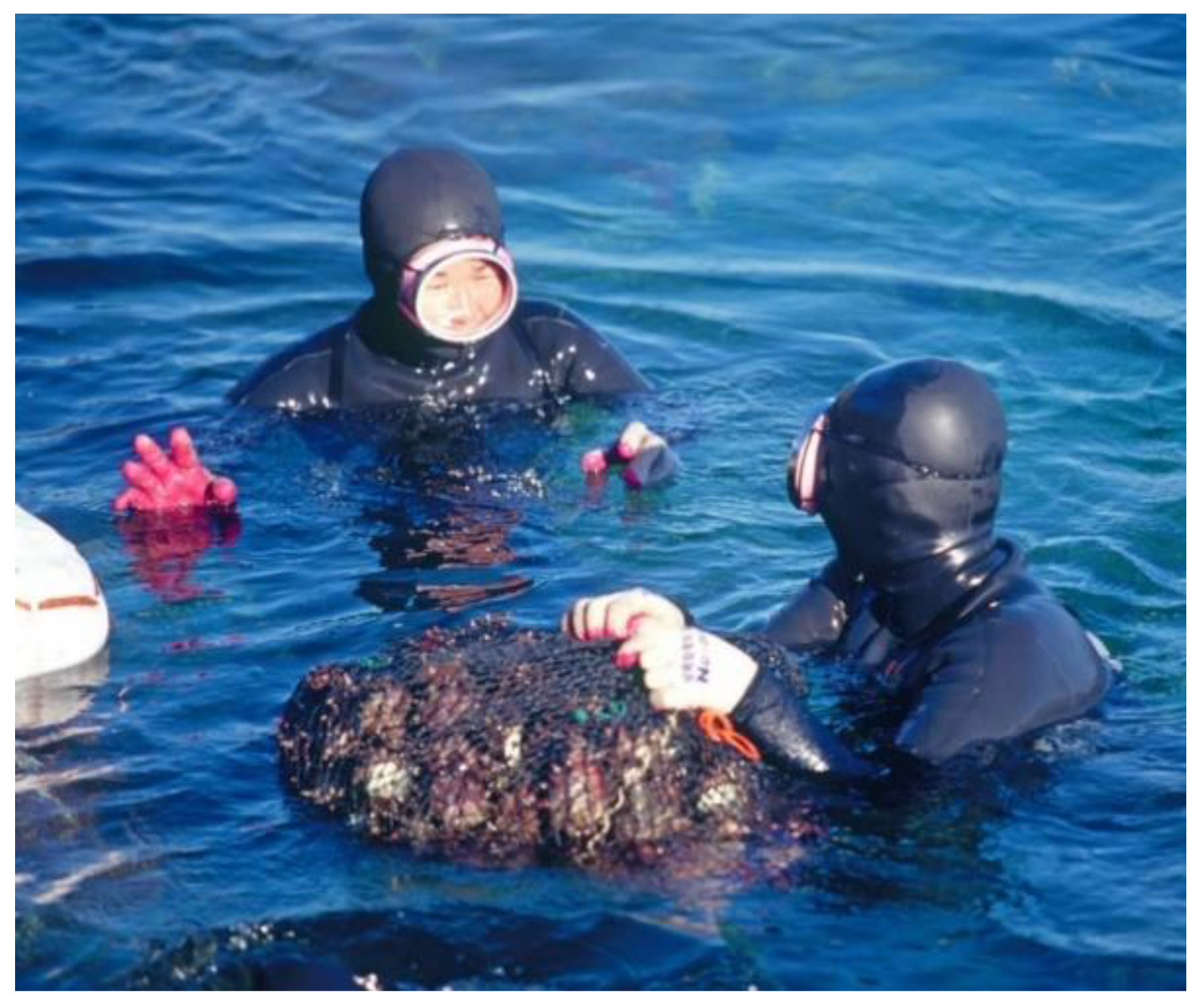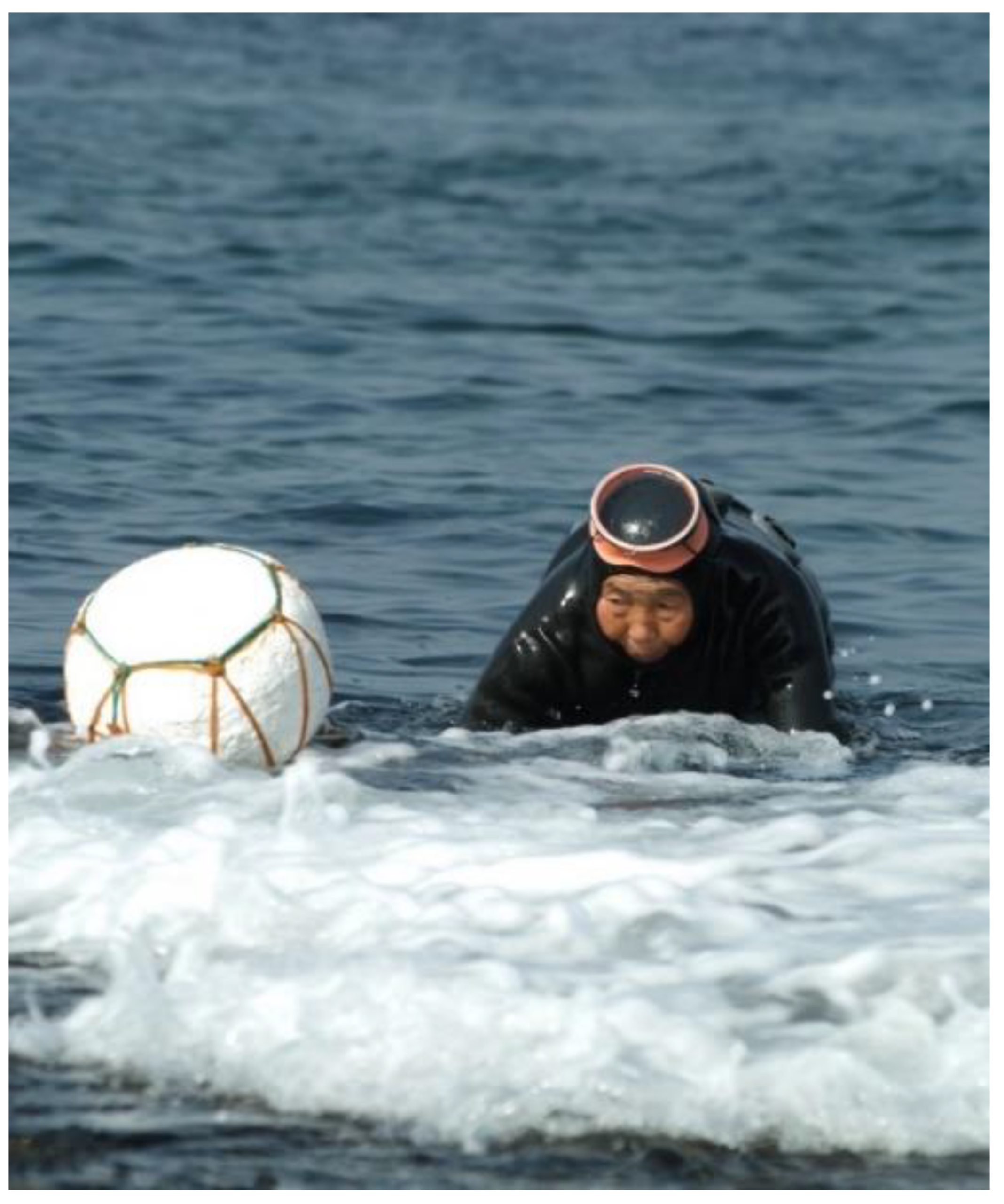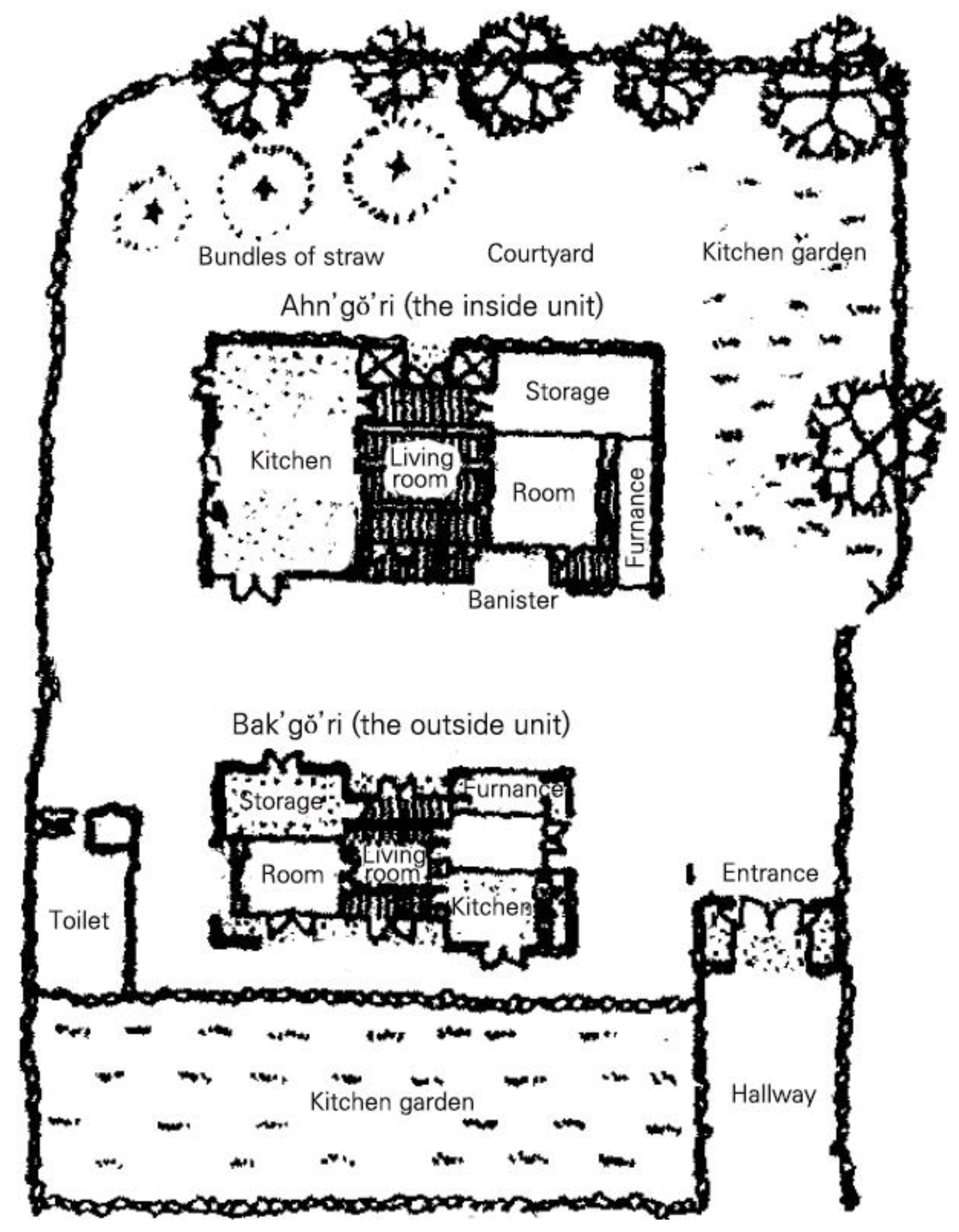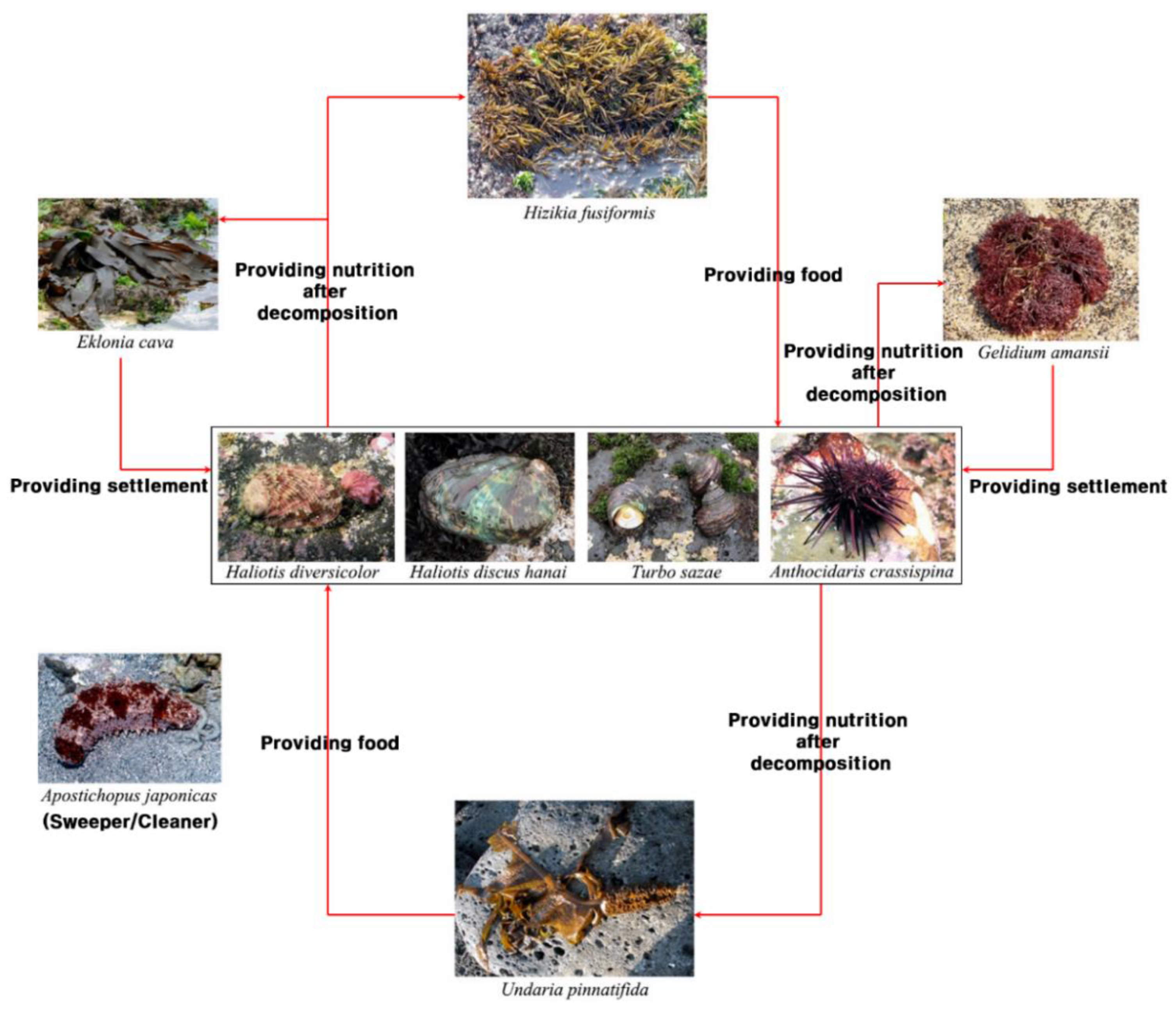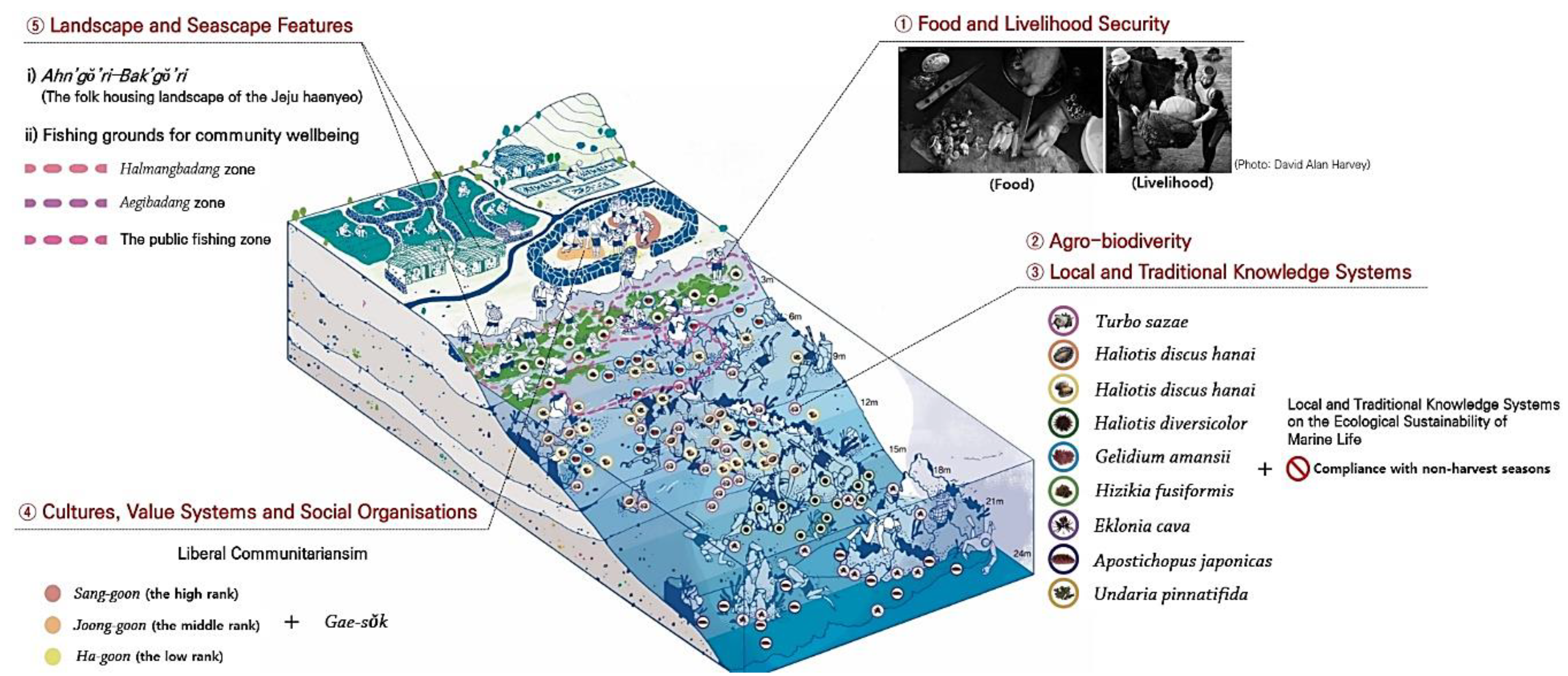Looking through the lens of GIAHS, the Jeju
haenyeo fisheries consist of five main pillars. Here, it must be highlighted that, in the Jeju
haenyeo fisheries, the five main pillars are all interlocked together. As shown above, the reciprocal relationship amongst the five pillars of the landscape of the Jeju
haenyeo fisheries starts from (i) food and livelihood security, goes through (ii) agro-biodiversity, (iii) local and traditional knowledge systems, and (iv) cultures, value systems, and social organizations, and ends in (v) landscape and seascape features [
8].
2.1. Food and Livelihood Security
The food and livelihood of Jeju
haenyeo have been secured by gathering marine products. The major marine products are nine in total:
Hizikia fusiformis,
Gelidium amansii,
Eklonia cava,
Undaria pinnatifida,
Apostichopus japonicas,
Anthocidaris crassispina,
Turbo sazae,
Haliotis discus hanai, and
Haliotis diversicolor. The economic value of the marine products that Jeju
haenyeo usually harvested rapidly increased in the early twentieth century. The main cause of the increase in the economic value of this seafood can be found in its exchange value. Jeju Island is a volcanic island, formed from a volcanic explosion. Jeju Island’s soil is composed of volcanic ash soil (soil consisting of volcanic ash). Jeju Islanders call fields formed from volcanic ash soil tteunttang or tteunbat. This natural geographical environment makes the land of Jeju Island infertile [
9].
The average annual precipitation in the coastal region of Jeju Island is 1568 mm, and, in the mountainous area of Mt. Hallasan, as much as 3000 mm falls as orographic rainfall. If this is averaged, it is 1918 mm (South Korea’s average is 960 mm, the world average is 743 mm), making it the area with the highest precipitation in Korea. Despite this, Jeju is made up of clay loam soil (clay content is 37.5%–50%), which is called “thick soil” (mud soil). Thus, except for a few areas in which soil with retention capacity is distributed, most areas become dry, and rice farming is not possible (ibid).
This lack of surface water retention is not only caused by the volcanic ash soil but also because of the topographical form of a shield volcano (aspite volcano), which is shaped like a shield placed upside down. This means that Jeju Island has little flat land. Thus, when it rains, the rainwater leaks into the sea through gareria (the Jeju dialect equivalent of wadi, which is like a dry riverbed where water only flows when it rains in the dry desert climate zone (BW climate)) quickly because of the short runoff distance, and thus, it is difficult for water to be retained. This lack of surface water is inevitably unfavorable for agriculture (ibid). The harsh soil of Jeju Island does not allow Jeju Islanders to get enough agricultural crops to exchange for other products. In other words, almost all of the agricultural crops are consumed only for their food.
Unlike agricultural crops harvested from fields, large amounts of marine products harvested from the sea are used for sale. That is, for Jeju
haenyeo, marine products are the most important cash cow. The following study of Takahashi, which is a typical portrait of the
haenyeo’s household economy, specifically shows that the income of
haenyeo in the individual household economy is a critical conduit through which the Jeju
haenyeo earn money [
10]. According to his study, in the household economy of Jeju Island, cultural expenses, especially education expenses, some energy expenses, clothing expenses, taxes, and other expenses, which are essential for cash consumption, are accounted for by cash collected from the marine products harvested by the
haenyeo (ibid).
Considering the marine products harvested from the sea to be a cash cow, one of the Jeju haenyeo wrote of her experience:
I had nothing, learned nothing, and couldn’t do business, either, but I knew how to dive into the water and catch seafood. And the only thing you need for muljil is sojungi (haenyeo’s traditional diving suit). For farming, you need to buy seeds and get fertilizer, but muljil was nothing like that. Because I knew how to dive at least, I could feed my kids and get clothes for them. My kids have never been embarrassed by me being haenyeo. Instead, they appreciate the work I do, so I’m proud of my profession.
(Interviewee: Song-Hwan Ko/Interview source: Jeju Haenyeo Museum)
Additionally, the seafood that the Jeju
haenyeo harvest are very important for their dietary life and nutrition.
Haenyo make their own food from the marine products they gather from the sea. They sell these goods for merchandising and made their own food, mainly using flawed shellfish or less popular marine plants. Although simple, the vigorous gathering activity of the
haenyo, despite the heavy energy consumption it brings, is supported by the food that the
haenyo have, which is made from fresh ingredients filled with rich nutrition. The reason that the
haenyo’s gathering work could last for such a long time is because the marine products gathered by the
haenyo are just as valuable [
11].
The same goes for the reason that the haenyo’s dietary life is essential; if nobody processed the ingredients into food, their value as food would be lost. The Jeju haenyo, who have regarded the sea as their base for living, proactively use the ecosystem of marine plants around the coast of volcanic rocks at which various ocean currents meet. Their improvised method of mixing marine plants into staples to resist famine in bad years eventually turned out to be valuable knowledge for decent nutritional intake. Even now, this food culture and folklore knowledge continues to be transferred in order to foster sustainable trends in modern food culture (ibid).
2.2. Agro-Biodiversity and Traditional Knowledge System
The reason that Jeju haenyeo could achieve food and livelihood security consistently is that the agro-biodiversity of the seafood that Jeju haenyeo harvest can be maintained. It seems that the “ecological niche” of the seafood of the Jeju haenyeo could be an effective way of expressing the meaning of the agro-biodiversity of the seafood. An American ecologist, Frank H. Heppner, related this to the notion of an ecological niche:
If a habitat is a street address, a niche is like a job description. An organism has a huge number of individual relationships with other organisms in its vicinity. If it is a predator, it has a relationship with the prey species—If the prey species should go extinct, the predator is in deep trouble… Most of these relationships are mutual. Prey affect predators, and predators affect prey… The sum of all the relationships in an organism’s existence is its niche in life. The word niche in ordinary English means a ‘little hollow place in a wall where you can put something, like a statue,’ so ecological niche is the little place where an organism fits in the general scheme of things [
12].
Each of the nine species that Jeju
haenyeo harvest has its own ecological niche, and all of them interconnect with each other (
Figure 2). The harvested seafood for Jeju
haenyeo comprises nine species, which are classified into three categories. The first is marine algae, the second is echinodermata, and the third is mollusca. Marine algae include
Hizikia fusiformis,
Gelidium amansii,
Eklonia cava, and
Undaria pinnatifida; echinodermata includes
Apostichopus japonicas and
Anthocidaris crassispina; and mollusca has
Turbo sazae, Haliotis discus hanai, and
Haliotis diversicolor.
These nine biological resources have been major resources for haenyeo for several decades. The nine species live from the sea surface to 25 m deep, creating an ecological cycle, which is a virtuous cycle of co-prosperity. First of all, Gelidium amansii and Eklonia cava create a habitat for Anthocidaris crassispina, Turbo sazae, Haliotis discus hanai, and Haliotis diversicolor, which feed on Hizikia fusiformis and Undaria pinnatifida and whose excretion is broken down into nutrition for Undaria pinnatifida, Gelidium amansii, and Eklonia cava, among others. Apostichopus japonicas help keep their habitat clean.
Jeju haenyeo have set the period for gathering sea products and controlled fishing activity to help grow and maintain an ecological cycle of their major sea product collection. Jeju haenyeo learned by themselves about the prohibition period for gathering folivorous marine resources and marine algae while working in the water, and they have passed down this information from generation to generation.
It is prohibited to catch folivorous marine resources such as
Turbo sazae,
Haliotis discus hanai, and
Haliotis diversicolor during their spawning season (
Table 1; the colored cells in the table refer to the non-harvest period). For
Turbo sazae, the prohibition period (spawning season) is from June to August. For
Haliotis discus hanai, it is from October to December, and for
Anthocidaris crassispina, it is from September to October. In the case of
Gelidium amansii,
Eklonia cava, and
Hizikia fusiformis, no prohibited periods have been determined traditionally. Usually, the harvesting period for
Apostichopus japonicas is from October to November.
Gelidium amansii is collected between April and July. For
Hizikia fusiformis, the usual collecting period is from April to May. For
Eklonia cava and
Undaria pinnatifida, it is from August to September and from May to July, respectively.
Along with the non-harvest seasons, Jeju haenyeo strictly adhere to size limits, as well. In particular, they strictly obey the size limits of Turbo sazae, Haliotis discus hanai, and Haliotis diversicolor: they must not catch Turbo sazae smaller than 7 centimeters, Haliotis discus hanai smaller than 10 centimeters, or Haliotis diversicolor smaller than 3.5 cm. The observance of harvest seasons for these sea products was developed by the haenyeo through their efforts to sustain marine biodiversity. In the traditional society, their knowledge about harvesting seasons was learned through their efforts to preserve marine biodiversity over a long history of fishing.
Jeju
haenyeo are ecological divers who, taking the sea as their main arena in the “life-world” [
13], embed in their life the ecological values based on the sustainable management of agro-biodiversity, which has been inherited through their local and traditional knowledge systems. In other words, the Jeju
haenyeo’s knowledge systems about the observance of harvest seasons for the sea products is embedded in the realm of the “bodily affect” [
14] of
haenyeo, not in that of conscious thinking, through the repeated process of unconscious habituation in the life-world.
Knowledge systems about the observance of harvest seasons for the sea products embedded in the realm of the bodily affect of
haenyeo mean that they exist as the affect of the Jeju
haenyeo through the process of embodiment. That is, the divers learned their local and traditional knowledge systems “with the body”, not with the head, through
muljil experiences in the sea, the main environment of their livelihood. Here, “what is learned with the body exists as the affect” [
15,
16,
17,
18,
19,
20,
21] is the key statement for comprehending the implication of the local and traditional knowledge systems of the Jeju
haenyeo.
One of the best examples for understanding “learning something with the body, not the head” is learning how to swim. Swimming is not something one learns with their head. It cannot be learned by means of linguistic or visual explanations or lessons. It can only be learned through the body. How to swim is embedded in your body through the “affect of water and your body” that occurs in the performative process of swimming. Eventually, your “body” becomes a unique conduit through which you can learn how to swim.
When swimming, your body reacts to the feeling that your body is slanted, pushed by the heavy current. The reaction is immediately made without undergoing the process of analytic thinking. Specifically, learning how to swim, you do not think analytically that the speed of the current is 0.5 m/s, and the right side of your body is tilted at an angle of 1.23°, so you need to move your arms at the speed of 0.232 m/s and your legs at the speed of 0.317 m/s, while maintaining a lung capacity of no less than 5000 mL [
22].
Without the aforementioned mathematical thinking, knowing how to swim exists as memories accumulated not in your brain but in your body. In other words, it remains as a fingerprint inscribed in your body through the affect about your bodily movement in the water, or the bodily affect [
19]. This explains the meaning of the “bodily affect”, the core implication of the Jeju
haenyeo’s local and traditional knowledge for the sustainable management of the agro-biodiversity of sea products [
23].
2.3. Cultures, Value Systems, and Social Organizations
Considering the fact that Jeju haenyeo have lived in an environment that contains this competitive exclusion principle—that is, an environment in which winners survive and losers fall behind—it can be inferred that the local and traditional knowledge systems for the sustainable management of agro-biodiversity of sea products are maintained amongst Jeju haenyeo. In spite of living in an environment that contains this competitive exclusion principle, the Jeju haenyeo have been able to become ecologists who pay attention to sustainable management for the agro-biodiversity of sea products; the reason for this success can be found in their cultures, value systems, and social organizations, which are manifested as the “liberal communitarianism-based hierarchical tradition” of the Jeju haenyeo.
The social organizations of the Jeju
haenyeo are based on the hierarchical tradition of diving
haenyeo, divided by their diving skills into
sang-goon (the high rank),
joong-goon (the middle rank), and
ha-goon (the low rank). The connectivity between the hierarchical tradition and the liberalistic aspect of the culture of the Jeju
haenyeo is best represented in the divers’ “self-ownership”, the backbone of liberalism [
23]. From the perspective of liberalists, the top priority of a good society is to absolutely ensure that its members enjoy the right of self-ownership [
24]. Self-ownership refers to the ownership rights one has over oneself. The term “oneself” here is purely reflexive in its meaning and indicates that the owner and the owned form a single, identical unit [
25].
The hierarchical tradition of the Jeju
haenyeo has its linkage to the liberalistic concept of “self-ownership” in that the criterion of “personal capability” extrudes that of “age” in deciding the hierarchy (in South Korea, all kinds of social organizations are based on hierarchical relations that are based on age) [
26]. Most distinctively, the rank of
haenyeo is thoroughly determined according to “the level of experience and skills concerning
muljil”, not the age of the divers. This means that any highly experienced and skillful diver can advance to the
sang-goon rank, even if she is younger than others. Conversely, it is possible that elderly divers are ranked low if they lack experience or skill. Growing old naturally increases the probability that
haenyeo will be categorized as
sang-goon divers, as they are likely to have accumulated experience and skill. It is obvious, however, that their age is not an absolute criterion for the
sang-goon group.
A diver’s experience and skill in
muljil originate absolutely from her own will and capability. As the Jeju
haenyeo decide their ranks according to the level of experience and skill that the diver accumulated through her efforts, the hierarchy implies the “complete guarantee of self-ownership”. In the liberalistic context, “it is moral to own only as much as one’s personal capability allows and not to take any measure other than one’s capability. A good community is a community that consists of those moral agencies that take moral actions” [
27].
As proven in the hierarchy of
sang-goon,
joong-goon, and
ha-goon, the Jeju
haenyeo thoroughly exclude age from the criteria of their social status; rather, they place their personal capabilities and responsibilities at the center of the constitution and the operation of their community. This traditional hierarchy exactly corresponds to liberalism, which avoids “an attempt to maintain one’s status by taking other measures than one’s capability and responsibility”, as it causes “damage to the unique right bestowed to others” [
24].
The distinction of the culture of the Jeju haenyeo can be found in the perfect balance of its liberalistic and communitarian values. In other words, the liberalistic values and the communitarian values of the culture are in a complementary relationship with one another in the cyclical architecture of the culture. The mechanism of this perfect balance of values clearly conforms to the communitarian significance hidden in the hierarchy of sang-goon (the high rank), joong-goon (the middle rank), and ha-goon (the low rank).
The previous paragraphs illustrate that the essence of the traditional hierarchy of the Jeju haenyeo lies in its thoroughly liberalistic values that focus on “personal capabilities and responsibilities”. Liberalistic values have a paradoxical linkage to the communitarian values when taking the “perspective that the community is the source of the principles of justice”. This perspective indicates that the principles of justice as the social standard were established not through non-historical, extrinsic norms but through historical, intrinsic norms.
In the communitarian context, the traditional hierarchy of
sang-goon,
joong-goon, and
ha-goon was created because the divers were aware that the existence of a member who fails to make the utmost efforts to improve her personal skills is nothing more or less than harmful for the entire community. Traditionally, the Jeju
haenyeo perceived “the non-exertive incompetent” as risk factors that erode “the shared sense of the common good” [
28] in the
haenyeo community. The hierarchy of
sang-goon,
joong-goon, and
ha-goon is social proof of the communitarian efforts that the Jeju
haenyeo made to minimize the number of “non-exertive incompetent” divers.
The most effective way to motivate the non-exertive incompetent in the community to make improvements is “to impose the sole responsibility on the individuals for the cost of their own choices” [
29]. In the
haenyeo community, a diver whose incompetence is considered to be due to a lack of effort would never be able to escape the socioeconomic status of
ha-goon and would be treated as such. By deciding that the hierarchy within the community depends on the individual capabilities and responsibilities of each individual, the Jeju
haenyeo attempt to maintain social tension in the community concerning the possible emergence of non-exertive incompetent members.
As much as they are wary of “effortless incompetent” members, the haenyeo community socially embraces those who may lack abilities but strive to contribute to the community, which is confirmed in gae-sŏk. “Gae-sŏk” refers to the tradition in which divers with larger yields put a certain amount of their catch into the mang-sari (net) of those with smaller yields. Generally, the divers in the sang-goon/joong-goon groups are expected to have larger yields, while those in the ha-goon group tend to have smaller yields.
Haenyeo consider it taboo to perform
muljil alone. They always work together with their buddies, under the principle that “no
haenyeo dive underwater without a buddy” (
Figure 5). In particular, either a
sang-goon or a
joong-goon diver performs
muljil in a pair with a
ha-goon diver. When the diver of a higher rank goes underwater, the one with the lower rank stays above the water and learns from the more skilled diver, while keeping an eye out for her safety. This is where the reciprocal duties occur.
The stake of the
ha-goon diver, who tends to have a smaller catch, emerges when making efforts to improve her diving skills by learning from the
sang-goon or
joong-goon diver and when contributing to the safety of the more skilled partner. Accordingly, the higher-ranked diver (
sang-goon) is obliged to give a certain portion of her catch to the lower-ranked diver (
ha-goon), and at the same time, the lower-ranked diver is obliged to receive it. If either of them neglects their duties of giving or receiving the catch, the diver who neglects the duty will lose her authority [
23].
In the communitarian context,
gae-sŏk signifies that the community of the Jeju
haenyeo is formed on the basis of the virtues of benevolence and solidarity. With the virtue of benevolence, the community forms the mindset of solicitude amongst its members, while the virtue of solidarity helps build a strong bond in the community on the basis of the solicitude of its members for each other. According to Michael Sandel, a communitarian philosopher, members of a community who establish a correlation of the virtues of benevolence and solidarity as a social value voluntarily respond to the needs of other people, which springs from their shared goal of benevolence and solidarity. Thus, they need not claim any rights over others [
30].
The aforementioned communitarian value exactly coincides with the social mechanism of
gae-sŏk. The tradition practiced among the Jeju
haenyeo is a cultural agent in which the
sang-goon/
joong-goon and the
ha-goon divers respond voluntarily to the needs of their community; therefore, none of them need to claim their respective rights. This implies that the cultural agent called
gae-sŏk represents the public responsibility that the members of the
haenyeo community build through the virtue of engaging in the public relationships of
muljil, rather than the obligation of the members for each other [
31,
32].
Another cultural practice that shows communitarian value is the designation of fishing grounds for community wellbeing.
Haenyeo on Jeju have designated special fishery zones in their village fishing grounds—the
Halmangbadang zone,
aegibadang zone, and the public fishing zone.
Halmangbadang, located in the intertidal zone, is for elderly
haenyeo who no longer dive or gather seafood as well as before, so they can go diving and harvest seafood without much difficulty (
Figure 6).
Aegibadang, also located in the intertidal zone, is designated for young and new
haenyeo who have little or no experience in underwater harvest work. Finally, the public fishing zone is a fishing ground designated for the development of village communities. Profits made from this public fishing zone are used for schools and public programs in the village. The designation of fishing zones for community wellbeing clearly shows that the Jeju
haenyeo fisheries are highly linked to communitarian value.
2.4. Landscape and Seascape Features
The cultures, value systems, and social organizations of Jeju
haenyeo, which are conceptualized as “liberal communitarianism”, are represented through the landscape and seascape features of Jeju
haenyeo fisheries. One of the most significant features of the Jeju
haenyeo fisheries landscape is the folk housing landscape of the Jeju
haenyeo, which is called
Ahn’gŏ’ri–
Bak’gŏ’ri [
23]. Traditionally, the folk housings of the Jeju
haenyeo basically feature two separate houses built in the same residential areas, surrounded by walls or fences (
Figure 7). The house located farthest from the front gate is referred to as “
Ahn’gŏ’ri” (the inside unit), while “
Bak’gŏ’ri” (the outside unit) refers to the house built nearest the gate. These buildings are also called “
U’nyŏk’gŏ’ri” (the upper unit) and “
Ahl’nyŏk’gŏ’ri” (the lower unit), depending on which is located at the highest altitude from the sea (ibid).
The core cultural aspects of the folk housing cultural landscape of the Jeju haenyeo can be categorized into two parts. The first is the completely separate living spaces between families led by the elderly parents and their married son. This means that the two different families maintain their own separate kitchens and live in their respective living spaces based on cooking in a completely independent manner. The second is the swapping of living spaces between families led by the elderly parents and their married son. Once the elderly parents reach the age of retirement, the parents (who live in Ahn’gŏ’ri) and their married son (who lives in Bak’gŏ’ri) trade houses. Even after the exchange, the two families maintain their separate kitchens and live independently in their respective living spaces through completely independent cooking routines.
Let us look into the first cultural feature of
Ahn’gŏ’ri–
Bak’gŏ’ri, that is, the completely separate living spaces (
Figure 8) between families led by the elderly parents and their married son. “Completely separate living spaces between the families led by the elderly parents and their married son” conforms with the completely independent kitchens/cooking between families led by the elderly parents and their married son. In the local folk culture, the separation of kitchens/cooking means the separation of the lives of women who take responsibility for cooking—that is, the mother of the married son and his wife. The connectivity of this separation from the perspective of cultural ecology can be found in the working hours of the married son’s mother and his wife, who are both
haenyeo and whose roles change depending on their age.
Considering the daily rhythms of the Jeju haenyeo, the daily working hours of the mother-in-law and the daughter-in-law vary as the elderly mother falls short of physical strength, while the daughter is capable of vigorously conducting muljil activities. Though unable to perform muljil, the elderly haenyeo, if still capable of basic physical activities, works in the field without exception, while their daughters-in-law work in the sea. This means that young haenyeo who are actively involved in muljil follow their daily working cycles by the multtae (tide time), while their mothers-in-law, who also work in the sea, also tune their working cycles to their personal conditions on the basis of their daily health condition.
The difference in the daily working cycles of the elderly haenyeo and her daughter-in-law (who is also a diver) connotes the fact that they have different cooking cycles. For instance, the mother finishes eating breakfast at 05:00 a.m. and leaves home to work in the field at 06:00 a.m., while her daughter-in-law finishes eating breakfast at 07:00 a.m. and goes to the sea to perform muljil at 08:00 a.m. Under these different cooking schedules, mother divers have traditionally prepared meals for themselves instead of forcing the cooking cycles of their daughters-in-law to fit those of their own. By doing so, the mothers have thoroughly separated the cooking cycles of the two generations.
The precept described above reveals the connectivity between the first cultural feature of Ahn’gŏ’ri-Bak’gŏ’ri (i.e., completely separate living spaces between families led by the elderly parents and their married son) and the Jeju haenyeo’s cultural tradition of liberalism. In the local folk society, mothers-in-law earned their livelihood according to their personal capabilities as haenyeo. As they were recognized and allowed opportunities according to their capacities under the competitive exclusion environment, relying on their daughters-in-law for food because of old age did not correspond to their life-long pursuit of “competition and independence”.
These women live with the cultural precept of not sharing the location of abalone with anyone, not even with their daughters. They are the pioneers of Jeju’s seas who never tell their daughters where they can find abalone, as a way of teaching them to survive. It is improbable that these divers, even when elderly, force their daughters-in-law to adjust their cooking cycles in order to prepare meals for them. In this context, the probability of the first cultural feature of Ahn’gŏ’ri–Bak’gŏ’ri (i.e., completely separate living spaces between families led by the elderly parents and their married son) can be found in the working hours of the married son’s mother and his wife, who are both haenyeo, whose roles change depending on their age. In other words, living in an environment that features this specific working schedule of haenyeo based on their age eventually led to the Jeju haenyeo’s pursuit of the cultural value of liberalism. Further, “its representation in the context of landscape” conforms to the folk housing landscape of Jeju, called Ahn’gŏ’ri–Bak’gŏ’ri.
The second cultural feature of
Ahn’gŏ’ri–
Bak’gŏ’ri—the exchange of living spaces between families led by elderly parents and their married son—is related to the cultural value of communitarianism of the Jeju
haenyeo. The significance of this tradition is revealed in the spatio-symbolic hierarchy of the
Ahn’gŏ’ri–
Bak’gŏ’ri. When reviewing the spaces from the perspective of structural anthropology, the aforementioned lifestyle of exchanging living quarters is obviously an inappropriate tradition. In structural anthropology, spaces are not homogeneous and feature qualitative segmentation and directionality [
33]. In other words, the inside and the outside are given the meaning of a good space and a bad space, respectively.
In the folk housing landscape of Ahn’gŏ’ri–Bak’gŏ’ri, as mentioned earlier, the houses have different names depending on their location. The house located farthest from the front gate is referred to as ‘Ahn’gŏ’ri’ (the inside unit), while ‘Bak’gŏ’ri’ (the outside unit) refers to the house built nearest to the front gate. These buildings are also called ‘U’nyŏk’gŏ’ri’ (the upper unit) and ‘Ahl’nyŏk’gŏ’ri’ (the lower unit), depending on which is located at the highest altitude from the sea. That is, Jeju’s traditional spatial structure is called ‘Ahn’gŏ’ri/U’nyŏk’gŏ’ri–Bak’gŏ’ri/Ahl’nyŏk’gŏ’ri’, featuring the ‘inside/upper–outside/lower’ spatial hierarchy.
In the residential lifestyles of Jeju haenyeo, the ‘inside/upper–outside/lower’ space exists as a homogeneous space, not as a good or bad space, which experiences no qualitative segmentation or directionality. In this paper, I refer to the phenomenon as the “neutralization of spatio-symbolic hierarchy”. The cultural–geographical mechanism of this neutralization in Ahn’gŏ’ri–Bak’gŏ’ri can be found in the Jeju haenyeo’s cultural tradition of pursuing communitarianism.
In the Jeju haenyeo society, the elderly parents pursue a rational lifestyle and values in order to survive in a harsh living environment with the competition exclusiveness principle. They voluntarily downgrade the hierarchy of their living space because they find no reason to reside in Ahn’gŏ’ri, the core household residence with a large living space, particularly when their working hours are shortened as a result of old age and when they are transferring the patriarchal rights to their married son. At this point, the cultural tradition of pursuing communitarianism acquires “social buoyancy”.
The elderly parents in the Jeju haenyeo society voluntarily relocate their living space from Ahn’gŏ’ri to Bak’gŏ’ri in support of their married son and his family, who should now survive in these harsh living conditions. In this process, the solidarity between the two generations becomes even more solidified, which is processed with the socio-political mechanism called the “ethical dynamics of care” between the elderly parents and their married son’s family.
The “solicitude” of the married son and his family in reciprocation for that of the elderly parents is expressed by living with them in the same residential area, not outside their walls, while elevating the status of the elderly parents to “sages” who provide them with knowledge and wisdom about the operation and management of the household. This is the core of the ethical dynamics of care between elderly parents and their married son’s family through which the intergenerational solidarity (separate but “not alone”) can be further solidified. Moreover, this dynamic is the decisive mechanism of the neutralization of the spatio-symbolic hierarchy in the folk housing landscape of Ahn’gŏ’ri-Bak’gŏ’ri.
As discussed above,
Ahn’gŏ’ri-Bak’gŏ’ri can be referred to as a representational mediation of the culture of liberal communitarianism of the Jeju
haenyeo, where their daily rhythm for economic activities and their survival strategies in harsh living conditions are interlocked. That is, the representational principle of forming the folk housing landscape is identical to the culture of ‘liberal communitarianism’ [
23].
